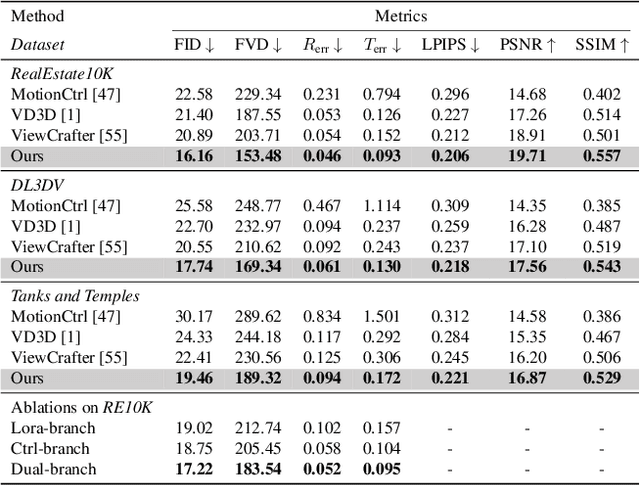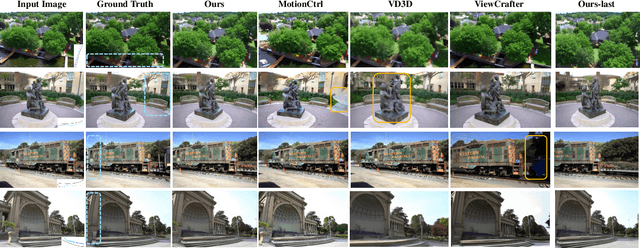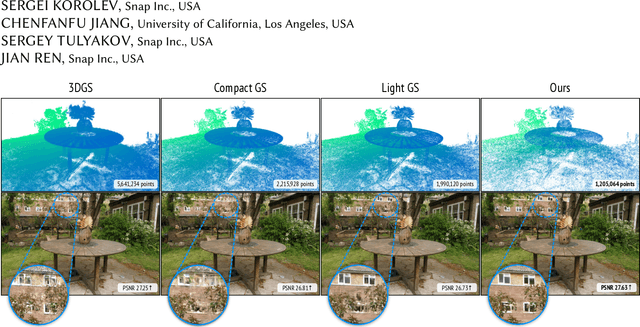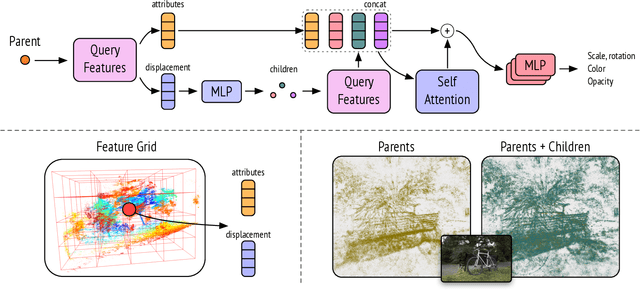Sergei Korolev
Towards Physical Understanding in Video Generation: A 3D Point Regularization Approach
Feb 05, 2025Abstract:We present a novel video generation framework that integrates 3-dimensional geometry and dynamic awareness. To achieve this, we augment 2D videos with 3D point trajectories and align them in pixel space. The resulting 3D-aware video dataset, PointVid, is then used to fine-tune a latent diffusion model, enabling it to track 2D objects with 3D Cartesian coordinates. Building on this, we regularize the shape and motion of objects in the video to eliminate undesired artifacts, \eg, nonphysical deformation. Consequently, we enhance the quality of generated RGB videos and alleviate common issues like object morphing, which are prevalent in current video models due to a lack of shape awareness. With our 3D augmentation and regularization, our model is capable of handling contact-rich scenarios such as task-oriented videos. These videos involve complex interactions of solids, where 3D information is essential for perceiving deformation and contact. Furthermore, our model improves the overall quality of video generation by promoting the 3D consistency of moving objects and reducing abrupt changes in shape and motion.
Wonderland: Navigating 3D Scenes from a Single Image
Dec 16, 2024



Abstract:This paper addresses a challenging question: How can we efficiently create high-quality, wide-scope 3D scenes from a single arbitrary image? Existing methods face several constraints, such as requiring multi-view data, time-consuming per-scene optimization, low visual quality in backgrounds, and distorted reconstructions in unseen areas. We propose a novel pipeline to overcome these limitations. Specifically, we introduce a large-scale reconstruction model that uses latents from a video diffusion model to predict 3D Gaussian Splattings for the scenes in a feed-forward manner. The video diffusion model is designed to create videos precisely following specified camera trajectories, allowing it to generate compressed video latents that contain multi-view information while maintaining 3D consistency. We train the 3D reconstruction model to operate on the video latent space with a progressive training strategy, enabling the efficient generation of high-quality, wide-scope, and generic 3D scenes. Extensive evaluations across various datasets demonstrate that our model significantly outperforms existing methods for single-view 3D scene generation, particularly with out-of-domain images. For the first time, we demonstrate that a 3D reconstruction model can be effectively built upon the latent space of a diffusion model to realize efficient 3D scene generation.
Lightweight Predictive 3D Gaussian Splats
Jun 27, 2024



Abstract:Recent approaches representing 3D objects and scenes using Gaussian splats show increased rendering speed across a variety of platforms and devices. While rendering such representations is indeed extremely efficient, storing and transmitting them is often prohibitively expensive. To represent large-scale scenes, one often needs to store millions of 3D Gaussians, occupying gigabytes of disk space. This poses a very practical limitation, prohibiting widespread adoption.Several solutions have been proposed to strike a balance between disk size and rendering quality, noticeably reducing the visual quality. In this work, we propose a new representation that dramatically reduces the hard drive footprint while featuring similar or improved quality when compared to the standard 3D Gaussian splats. When compared to other compact solutions, ours offers higher quality renderings with significantly reduced storage, being able to efficiently run on a mobile device in real-time. Our key observation is that nearby points in the scene can share similar representations. Hence, only a small ratio of 3D points needs to be stored. We introduce an approach to identify such points which are called parent points. The discarded points called children points along with attributes can be efficiently predicted by tiny MLPs.
 Add to Chrome
Add to Chrome Add to Firefox
Add to Firefox Add to Edge
Add to Edge